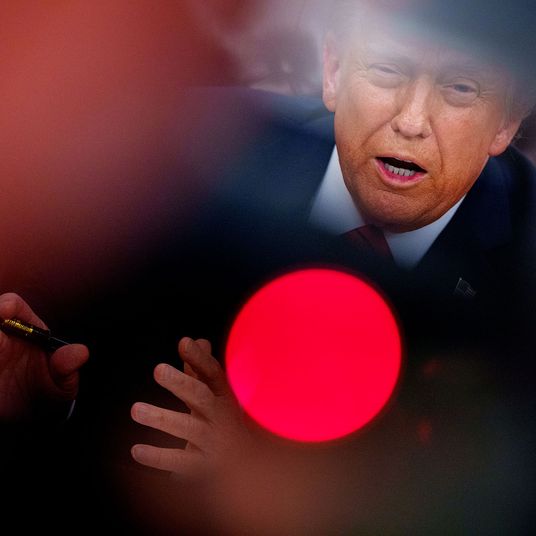
For much of Joe Biden’s presidency, the state of the economy has been weird. During his first two years in office, U.S. employers were adding jobs at a historic pace, while households boasted exceptionally strong balance sheets thanks to pandemic relief legislation. But inflation also soared to its highest level in four decades, triggering a decline in real wages. Meanwhile, supply-chain dysfunction created shortages of cars and some electronics. Many small businesses struggled to find adequate staff, leading to widespread declines in customer service. Americans did not look kindly on this mixed bag, giving the economy poor marks in opinion polls. Making matters worse, there was a broad consensus among economists that the Federal Reserve would need to drive the economy into recession in order to stabilize prices.
But in 2023, the economic landscape has grown more uniformly pleasing. In June, inflation cooled for the 12th straight month with the consumer price index growing at a 3 percent annual rate. In June 2022, that CPI was growing at a 9.1 percent annual clip. This disinflation has led Wall Street analysts to slash estimates of recessionary risk with Goldman Sachs now saying there is only a 20 percent chance of an economic downturn in the U.S. over the next 12 months.
As prices decelerated, employment and wages have remained strong. Prime-age labor-force participation is near all-time highs, while the unemployment rate sits near half-century lows. According to a Bureau of Labor Statistics report released Friday, the U.S. economy added 187,000 jobs in July. Average hourly earnings, meanwhile, were up roughly 4.5 percent from a year earlier, meaning that wages have been rising faster than prices, enabling workers to reclaim some of the purchasing power they lost to post-COVID inflation.
July’s jobs total came in slightly below expectations. But at this point, a slow and steady expansion of hiring could prove more sustainable than a rapid one, as too much labor demand too quickly could reaccelerate price growth. That in turn could lead the Federal Reserve to hike interest rates more aggressively, thereby increasing the risk of recession.
For much of Biden’s tenure, there’s been a perceived tradeoff between wage growth and the risk of recession since rising labor costs can produce higher consumer prices, which can trigger steeper rate hikes. But there is a way for wages to rise without significantly increasing costs for firms: if productivity, or output produced per work hour, increases.
Productivity is infamously difficult to measure at the aggregate level. During recessions, productivity almost invariably increases, but this is not because economic downturns are great for innovation. Rather, in a recession, firms typically lay off their least productive workers. With the work hours of such laborers subtracted from the equation, productivity goes up.
For this reason, as the employment rate recovered during Biden’s first years in office, labor productivity went down. But now, we’re starting to see productivity gains that can’t be attributed to low employment at the bottom rungs of the labor market. In the second quarter of this year, nonfarm labor productivity grew at a 3.7 percent annual pace, outstripping the 2.2 percent rate that economists expected and rebounding sharply from the 1.2 percent decline during this year’s first three months.
This is just one data point. We’ll need more quarterly results before we know whether this represents a real, durable increase in productivity. But as Skanda Armath of Employ America argues, there are some reasons to expect such a positive trend.
For one thing, workers tend to get more productive once they’ve been on a job for a sustained period of time. The pandemic reshuffled the labor market, as many millions of workers switched jobs, or even industries, in the span of two years. That means that firms had to train new staffers en masse. Now, as the labor market has stabilized, those workers should become more adept at their new roles.
Real fixed investment is also a key driver of productivity: The more firms invest in productive machinery, the more easily they can increase output per work hour. Such investment has been depressed in recent years, due in part to pandemic-induced increases in the cost of materials. But construction costs have fallen in recent months and are now decelerating on an annual basis. The prices of steel, aluminum, sand, and cement shot up to extraordinary levels in 2022 and are now falling back down to Earth. And private fixed investment in equipment has started to tick back up accordingly.
What’s more, investment is especially robust in high-end manufacturing, which tends to have especially strong productivity. Construction spending in that sector dwarfs that in the less productive health-care and education industries.
This is attributable, in no small part, to the Biden agenda, which poured public investment into the semiconductor and green-tech industries. Semiconductor production is disproportionately concentrated in the so-called “Mountain” region, which has therefore seen an especially sharp increase in manufacturing investment since the CHIPS Act’s passage.
There are still plenty of ways for the economic outlook to darken. It is possible that the recent slowdown in job growth augurs an impending labor-market contraction, as the Fed’s interest-rate hikes finally start to bite. Conversely, if labor markets remain tight and wage growth accelerates, inflation could rebound. But for the moment, the Biden economy has never looked healthier.


































